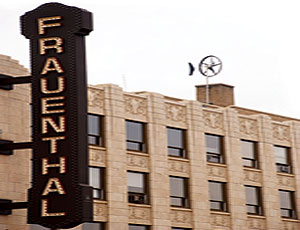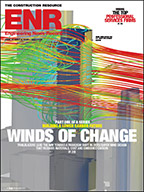As large-scale wind farms continue to multiply across rural landscapes, building owners in denser locations are looking to save some green with pint-sized wind turbines. But the financial reward is not always the biggest factor weighing on owners’ minds, experts say.

Concerns over energy prices and fossil fuels also have small wind blowing from all directions. The Brooklyn Navy Yard Development Corp. is spending $25 million to put up rooftop turbines in New York, while a $11.2-million, low-income housing project designed by Helmut Jahn in Chicago has been generating rooftop power since 2007. A low-noise, 1.5-kilowatt turbine atop a 78-year-old theater in the sagging, industrial town of Muskegon, Mich., started turning this summer and is breathing life into renewables there. Even late-night comedian and gas-guzzling car collector Jay Leno has a wind turbine atop his Big Dog Garage in Burbank, Calif.
Though fashionable, buying a roof-mounted turbine is not always a breeze. In some cases, doing so flies in the face of wind engineering, which dictates that wind power is not as efficient in dense, urban areas as the open spaces of America’s heartland and offshore, experts say. Suppliers say there is more to selling wind turbines than a cost-benefit analysis.
In some cases, installing a small turbine on a city rooftop is “like putting a solar panel in the shade,” explains Ron Stimmel, a small-wind advocate for the American Wind Energy Association. “Ninety times out of 100, you are better off with a solar panel.”
Siting is critical when installing a small turbine, which typically is less than half the cost of solar panels, suppliers say. Then, there is the problem of the small rotor. “Output is very tightly correlated with size,” says Stimmel. “When you see a turbine the size of a dinner plate saying it can power a house, there are laws of physics that make it impossible.” Small wind is defined as mills rated at 100 KW or less, according to AWEA. Typically, those rotors are several feet in diameter, while large turbines come in diameters and capacities up to 300 ft and 5 MW.
Small turbines are not seen as a holistic alternative to grid power but rather a supplement. “As long as the wind is blowing 8 mph or higher, it will be generating energy,” says Jessica Lehti, marketing manager for Grand Rapids, Mich.-based Cascade Engineering, which built the European-designed Swift mill used in Muskegon. Payback time depends on location, she adds, but not all green-conscious owners are thinking about their bank accounts: “I pay an extra $10 a month to recycle, and all I get is a good feeling.”
The decision usually starts with an energy audit, typically performed by the manufacturer or a consulting engineer at a cost of about $500. “First and foremost, you have got to figure out if you have a location that works,” explains Arnold Boezaart, vice president of the nonprofit Community Foundation for Muskegon County, which in August installed the Swift turbine on its five-story Frauenthal Center for the Performing Arts at a cost of about $10,000, paid for by an eco-friendly donor. A four-month audit of the theater’s roof prior to installation found that wind was gustier there than at the nearest airport.
But the Muskegon mill has generated more public awareness than power. Then again, that was the intent. “First of all, it was to introduce small wind to the community,” Boezaart says. “And No. 2 is to generate a little electricity.” The mill is rated for 2,000 KWh per year and in three months has cranked out about 70 KW hours—a small fraction of the building’s power needs.
Still, the merits of small wind are not all hype. AWEA’s latest report, published in June, estimates that manufacturers sold 9,092 small turbines last year at a cost of $42 million, representing annual growth of 14%. More than 99% were mounted on aluminum poles in homeowners’ backyards. “The interest is going toward rooftop turbines, but that’s not where the market is going,” Stimmel says. Since the fall, owners have had more incentives to weigh, he says. A federal-tax credit included in October’s bank bailout gives the windy alternative a boost by offsetting one-third, or up to $4,000, of the cost.




Post a comment to this article
Report Abusive Comment